Is It More Dangerous To Drive Or Fly? Flying, especially in general aviation, involves risks that often surpass those of driving, making it crucial to understand the factors contributing to aviation incidents and how to mitigate them. At flyermedia.net, we delve into these safety considerations, offering insights into aviation safety, risk factors, and preventive measures. Understanding these aspects can empower pilots, aviation enthusiasts, and travelers to make informed decisions and enhance safety in the skies. Explore aviation risks and safety protocols with us for a secure flying experience.
1. Understanding the Statistics: Driving vs. Flying
Is it more dangerous to drive or fly when considering the statistical data? Comparing the safety of driving versus flying requires careful analysis due to differing reporting methods. The National Highway Traffic Safety Administration (NHTSA) measures accidents per 100 million vehicle miles traveled, while the National Transportation Safety Board (NTSB) uses accidents per 100,000 flight hours for aviation incidents. Understanding these metrics helps to compare the risks associated with each mode of transportation accurately. By analyzing these statistics, we can gain valuable insights into aviation safety and improve risk management strategies.
1.1. Comparing Accident Rates
Is it more dangerous to drive or fly when we directly compare accident rates? The disparity in reporting methods between driving and flying makes direct comparisons challenging. However, a 2020 study offers a solution by providing a common metric: fatal car crashes per million hours driven. This study reports 0.6 to 0.7 fatal car crashes per million hours driven, varying from 1.05 for young drivers to 0.45 for older drivers. This benchmark allows us to evaluate general aviation (GA) accident rates against driving.
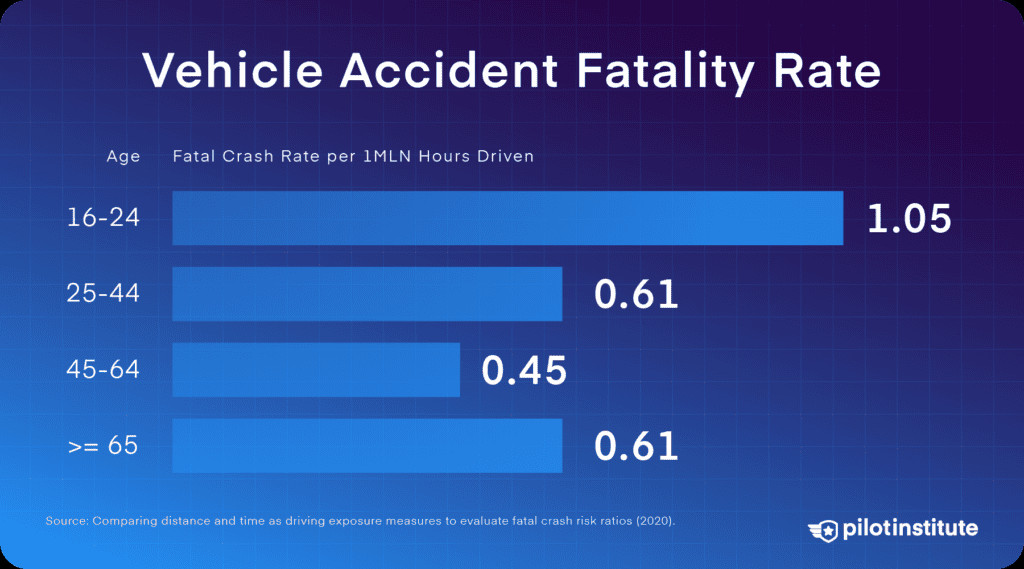 Vehicle accident fatality rate by age
Vehicle accident fatality rate by age
1.2. Motorcycle Accident Rates
Is it more dangerous to drive or fly compared to riding a motorcycle? NHTSA data indicates that motorcycle accidents with fatalities occur about 27 times more frequently than car accidents per vehicle mile. This translates to approximately 16 to 18 fatal motorcycle accidents per million hours ridden, making motorcycles significantly riskier than driving. These figures provide a valuable point of comparison when assessing the risks of general aviation.
1.3. Overall General Aviation (GA) Accident Rates
Is it more dangerous to drive or fly when considering overall GA accident rates? According to the NTSB, there were 0.95 fatal GA accidents per 100,000 flight hours in 2021. This converts to 9.5 fatal crashes per million flight hours, about 14 times the driving fatality rate. While GA flying is riskier than driving, it’s about half as risky as riding a motorcycle. Understanding these numbers is crucial for anyone involved in or considering general aviation.
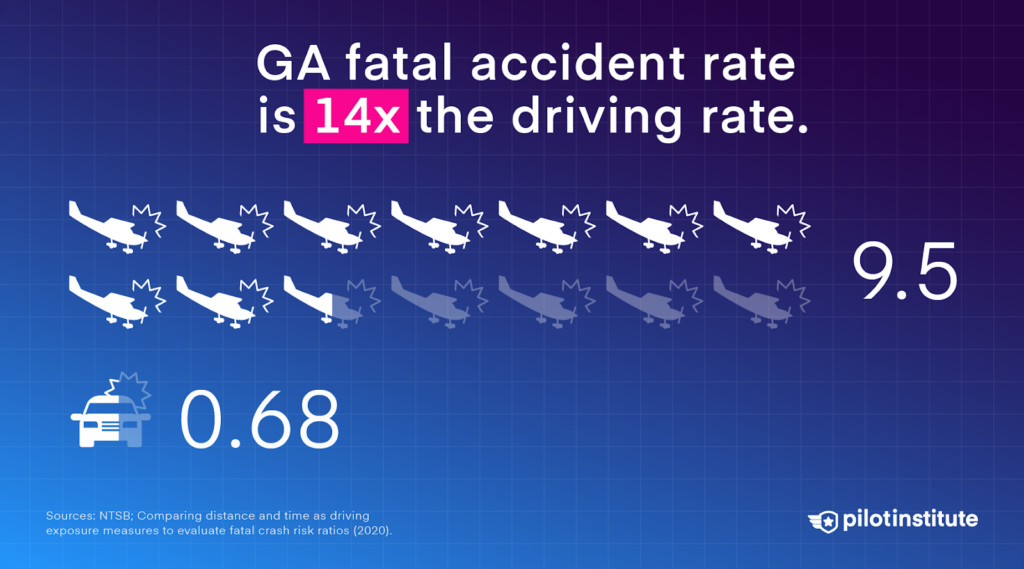 The GA fatal accident rate is roughly 14 times that of driving
The GA fatal accident rate is roughly 14 times that of driving
1.4. Personal Flight Accident Rates
Is it more dangerous to drive or fly for personal flights specifically? Personal flights, which include recreational flying, account for a significant portion of GA accidents. Between 2012 and 2021, personal flights saw 21.1 fatal accidents per million flight hours. This rate is over 27 times the driving fatality rate, making personal flights more dangerous than both driving and riding a motorcycle.
 Personal flights account for the majority of total GA accidents and fatalities
Personal flights account for the majority of total GA accidents and fatalities
1.5. Instructional Flight Accident Rates
Is it more dangerous to drive or fly for instructional flights? Instructional flights are generally safer than personal flights. Instructional flights saw 2.3 fatal accidents per million flight hours, which is 3.4 times more dangerous than driving. This lower rate is due to the structured environments, supervised operations, and higher pilot proficiency typically associated with flight training.
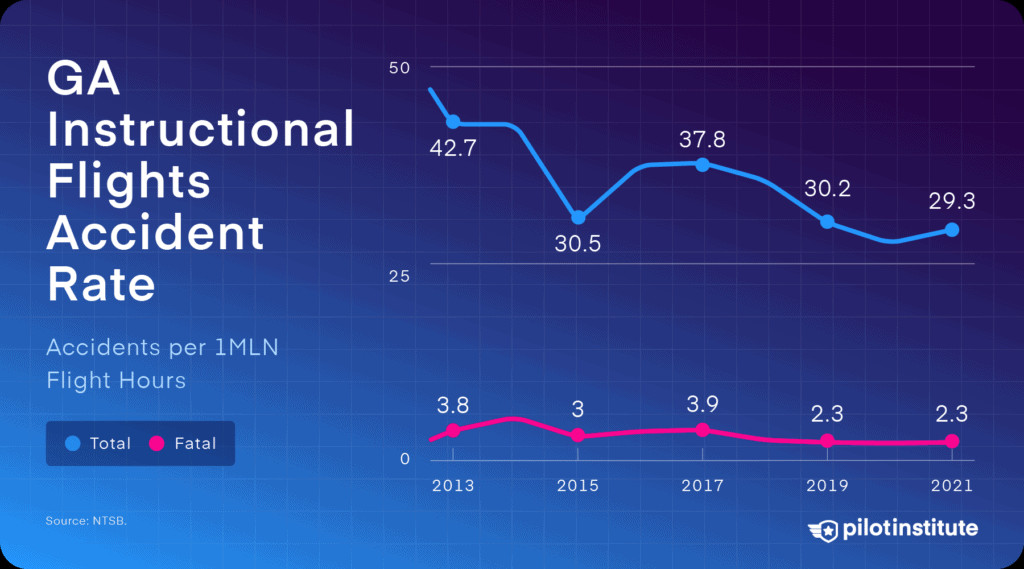 GA instructional flights accident rate: 2012-2021
GA instructional flights accident rate: 2012-2021
2. Key Risk Factors in General Aviation
Is it more dangerous to drive or fly because of specific risk factors in general aviation? Identifying the key risk factors in general aviation is essential for enhancing safety and reducing accidents. These factors are typically categorized as pilot-related, mechanical, and other/unknown causes. Understanding the prevalence and impact of each category can help pilots and aviation professionals mitigate potential hazards.
2.1. Pilot-Related Causes
Is it more dangerous to drive or fly due to pilot errors? Pilot-related causes are the most significant factor in GA accidents. In 2021, pilot error was deemed the cause in 69% of all GA accidents. These errors can range from loss of control inflight to poor decision-making, highlighting the critical role of pilot training, proficiency, and judgment in ensuring flight safety.
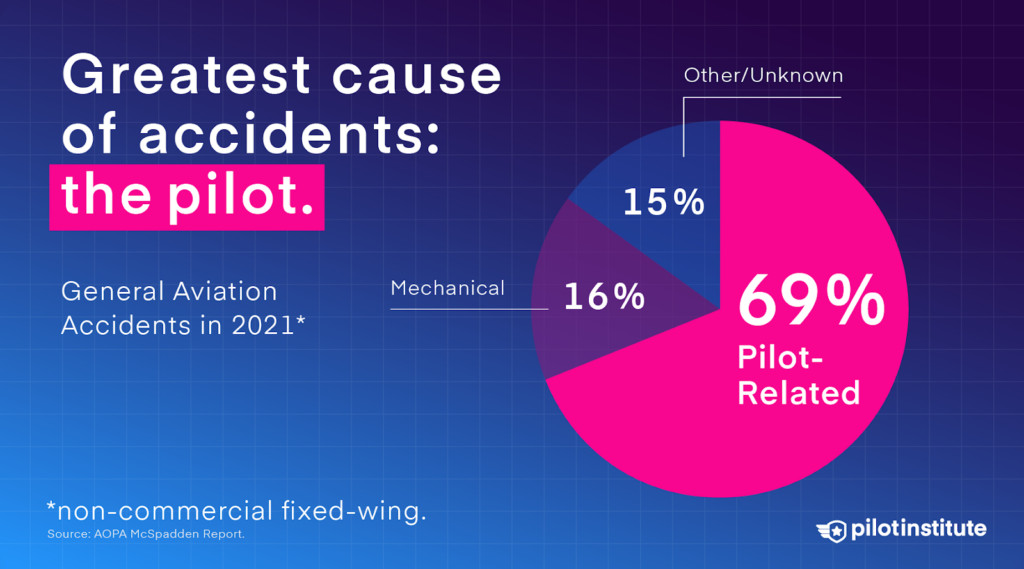 The greatest cause of GA accidents is the pilot
The greatest cause of GA accidents is the pilot
2.2. Mechanical Causes
Is it more dangerous to drive or fly due to mechanical failures in aviation? Mechanical issues are the second most common cause of accidents in general aviation. In 2021, mechanical failures comprised approximately 16% of all accidents but only 7% of fatal ones. While mechanical issues are less frequently fatal, addressing these issues through thorough maintenance and inspections is crucial.
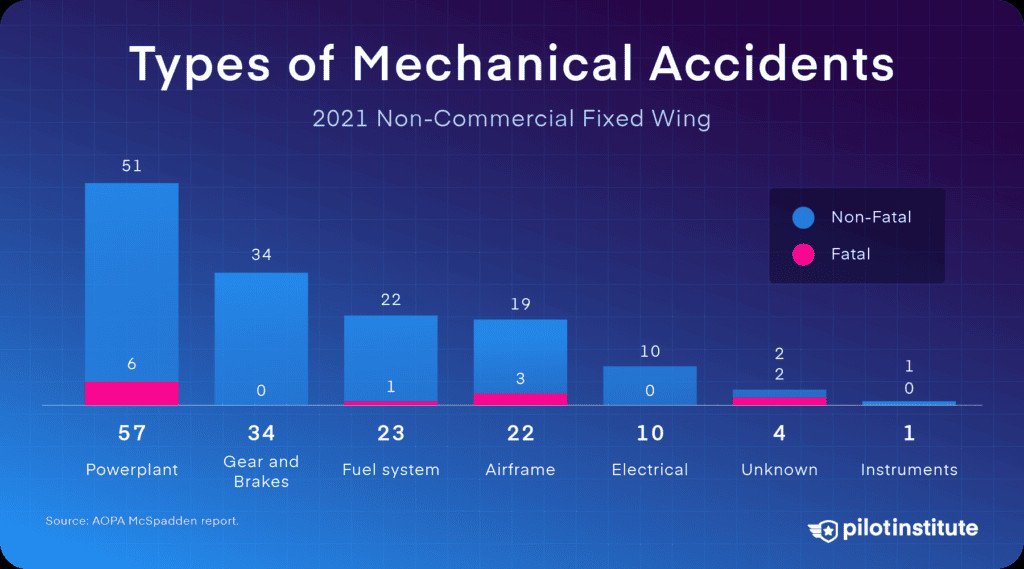 Types of GA mechanical accidents
Types of GA mechanical accidents
2.3. Engine Failures
Is it more dangerous to drive or fly due to engine failures? Engine failures are a significant concern in aviation, but surprisingly, they are not always fatal. In 2021, there were 57 reported engine failures, but only six resulted in fatalities. Factors such as pilot skill, emergency procedures, and the availability of suitable landing sites can influence the outcome of an engine failure.
 Six out of 57 engine failure accidents in 2021 were fatal
Six out of 57 engine failure accidents in 2021 were fatal
2.4. Fuel-Related Issues
Is it more dangerous to drive or fly because of fuel management problems? Fuel-related issues, including fuel contamination, fuel starvation, and fuel exhaustion, are significant contributors to mechanical-related accidents. Fuel contamination occurs when substances other than fuel enter the tank, while fuel starvation results from fuel not reaching the engine. Fuel exhaustion happens when pilots run out of fuel, often due to poor flight planning. Addressing these issues through diligent pre-flight checks and careful fuel management is essential for safety.
 Types of GA fuel management accidents
Types of GA fuel management accidents
2.5. Loss of Control In-Flight (LOC-I)
Is it more dangerous to drive or fly due to the risk of losing control in-flight? Loss of control in-flight (LOC-I) is a leading cause of accidents and fatalities in general aviation. LOC-I occurs when a pilot loses the ability to maintain the desired flight path and attitude of the aircraft. Factors such as stalls, spins, uncoordinated control inputs, and turbulence can lead to LOC-I, emphasizing the need for robust pilot training and proficiency in handling various flight conditions.
2.6. Landing Accidents
Is it more dangerous to drive or fly during the landing phase of a flight? Landing accidents are common in general aviation but are typically less fatal than other types of accidents. The most common landing accident involves loss of control, often due to factors such as wind shear, improper approach speeds, and runway conditions. While landing accidents may not always result in fatalities, they can cause significant damage to the aircraft and potential injuries to occupants.
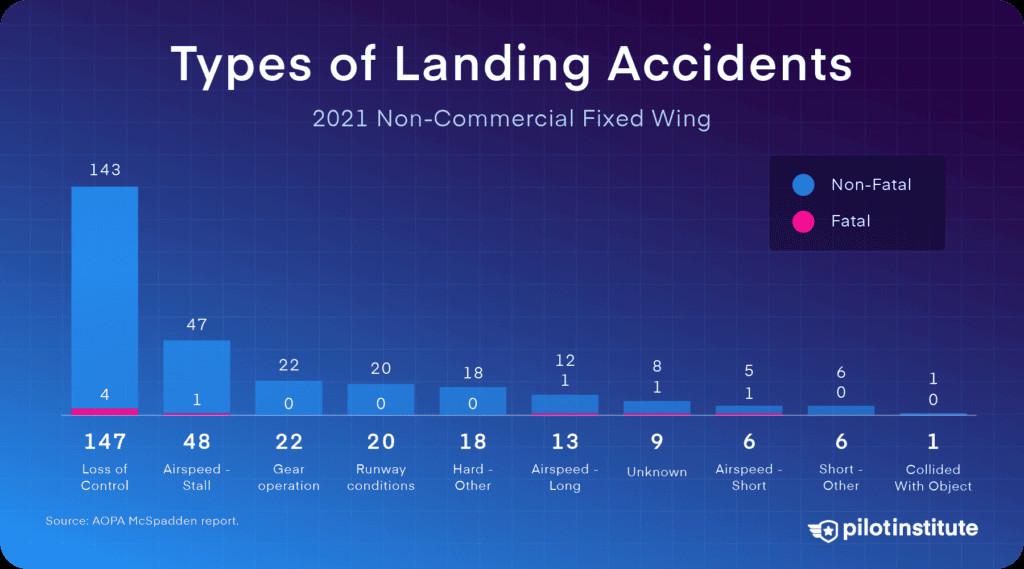 Types of GA landing accidents
Types of GA landing accidents
2.7. Takeoff and Climb Accidents
Is it more dangerous to drive or fly during takeoff and climb? Takeoff and climb accidents have a higher fatality rate compared to landing accidents. During takeoff and climb, the aircraft is in a low-energy, low-altitude state with a high angle of attack, leaving little margin for error in an emergency. Stalls are a significant cause of takeoff and climb accidents, highlighting the importance of maintaining proper airspeed and angle of attack during these critical phases of flight.
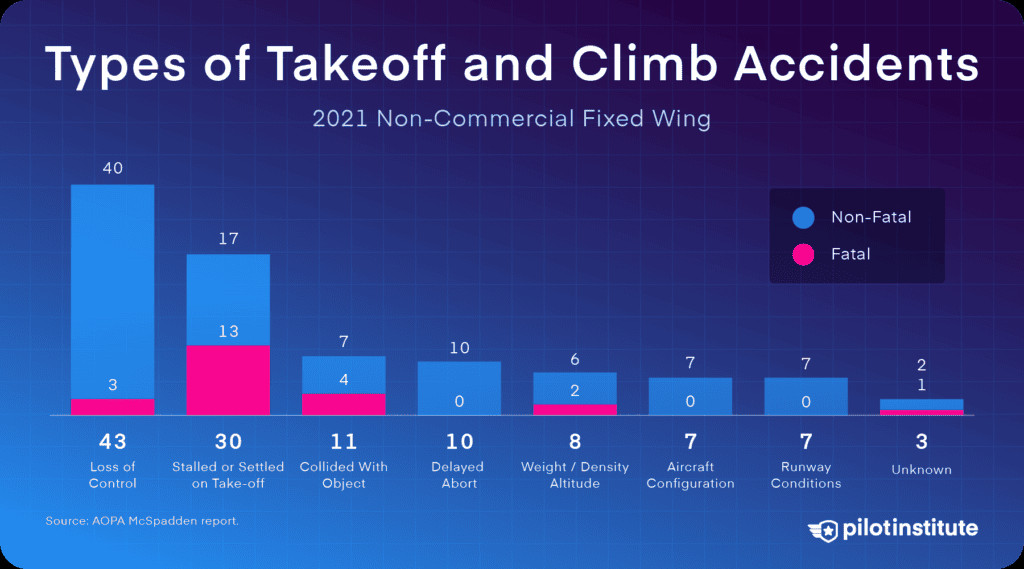 Types of GA takeoff and climb accidents
Types of GA takeoff and climb accidents
2.8. Controlled Flight Into Terrain (CFIT)
Is it more dangerous to drive or fly due to the risk of controlled flight into terrain? Controlled Flight Into Terrain (CFIT) is a critical concern in aviation safety. CFIT occurs when an aircraft is unintentionally flown into the ground or an obstacle, often due to a loss of situational awareness or attempts to fly below minimums during instrument procedures. Preventing CFIT requires pilots to maintain heightened situational awareness, adhere to standard operating procedures, and use available tools and technologies to enhance terrain awareness.
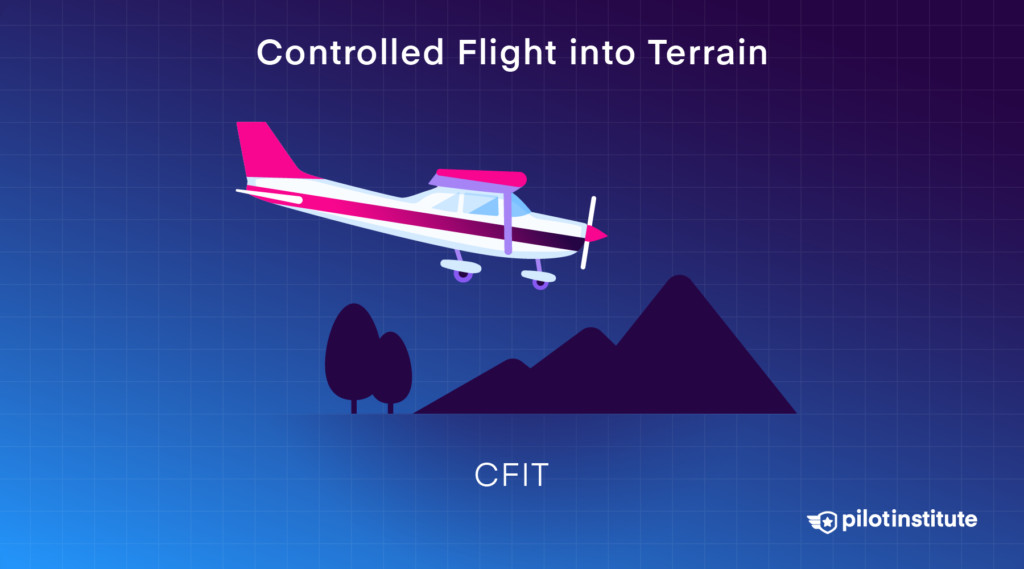 Controlled Flight into Terrain: a top cause of fatal accidents
Controlled Flight into Terrain: a top cause of fatal accidents
2.9. Unintended VFR Flight into IMC
Is it more dangerous to drive or fly because of the dangers of unintended VFR flight into IMC? Unintended VFR flight into Instrument Meteorological Conditions (IMC) is a significant risk factor in general aviation. Accidents caused by flying visually into clouds or low visibility had a high fatality rate. Pilots must be vigilant in monitoring weather conditions, avoiding flight into IMC, and being proficient in instrument flying techniques to mitigate this risk.
 Unintended VFR flight into IMC has a 71% fatality rate
Unintended VFR flight into IMC has a 71% fatality rate
3. Implementing Safety Measures and Best Practices
Is it more dangerous to drive or fly, and what safety measures can be implemented? While general aviation flying may never be as safe as driving, implementing robust safety measures and best practices can significantly reduce risk. Drawing lessons from instructional flights and airline operations, GA pilots can adopt a safety-conscious mindset, prioritize proficiency, and adhere to structured procedures to enhance flight safety.
3.1. Learning from Instructional Flights
Is it more dangerous to drive or fly, and what can we learn from the safety of instructional flights? The lower accident rate in instructional flights provides valuable insights into enhancing safety in general aviation. Factors contributing to the safety of instructional flights include supervised environments, structured operations, risk-averse attitudes, high maintenance standards, and proficient instructors. Emulating these practices can help GA pilots mitigate risks and improve flight safety.
3.2. Modeling a Safety Mindset
Is it more dangerous to drive or fly, and how can a safety mindset improve aviation? GA pilots can enhance their safety by modeling a safety mindset similar to that found in airline operations. This involves prioritizing proficiency, adhering to structured procedures, and making informed decisions based on risk assessments. By emulating these practices, GA pilots can mitigate risks and improve their overall safety record.
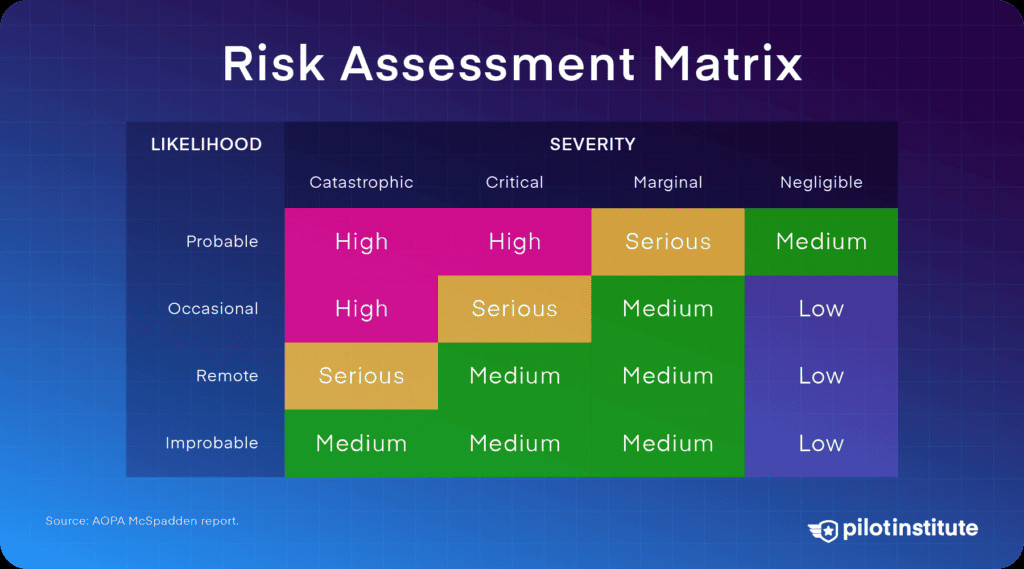 FAA Risk Assessment Matrix
FAA Risk Assessment Matrix
4. Practical Tips to Mitigate Risks in General Aviation
Is it more dangerous to drive or fly, and what practical tips can mitigate risks in general aviation? Mitigating risks in general aviation requires a comprehensive approach that includes ongoing training, meticulous pre-flight checks, sound decision-making, and adherence to best practices. By implementing these practical tips, pilots can significantly reduce their risk exposure and enhance flight safety.
4.1. Continuous Training and Proficiency
Is it more dangerous to drive or fly, and how does continuous training improve aviation? Staying proficient is critical for GA pilots. Regular training, recurrent checks, and participation in safety programs can help pilots maintain and improve their skills, knowledge, and decision-making abilities. Continuous training ensures that pilots are well-prepared to handle various flight scenarios and emergencies, reducing the likelihood of accidents.
4.2. Thorough Pre-Flight Checks
Is it more dangerous to drive or fly, and why are pre-flight checks important? Performing thorough pre-flight checks is essential for identifying potential mechanical issues and ensuring that the aircraft is in safe operating condition. Pilots should meticulously inspect the aircraft, review maintenance records, and conduct thorough checks of all critical systems before each flight.
4.3. Sound Decision-Making and Risk Assessment
Is it more dangerous to drive or fly, and how does sound decision-making improve aviation? Making informed decisions based on a thorough risk assessment is crucial for mitigating risks in general aviation. Pilots should carefully evaluate weather conditions, aircraft performance, pilot capabilities, and other relevant factors before each flight.
4.4. Adherence to Best Practices
Is it more dangerous to drive or fly, and why should best practices be adhered to? Adhering to best practices and standard operating procedures can significantly enhance safety in general aviation. Pilots should follow established procedures for all phases of flight, from pre-flight planning to post-flight procedures.
5. The Role of Technology in Enhancing Aviation Safety
Is it more dangerous to drive or fly, and how can technology enhance aviation safety? Technology plays a crucial role in enhancing aviation safety by providing pilots with advanced tools and systems that improve situational awareness, decision-making, and aircraft performance.
5.1. Advanced Avionics Systems
How do advanced avionics systems make it less dangerous to drive or fly? Advanced avionics systems, such as glass cockpits, GPS navigation, and electronic flight displays, provide pilots with real-time information about aircraft performance, weather conditions, and terrain. These systems enhance situational awareness and reduce pilot workload, allowing pilots to make more informed decisions and respond effectively to changing conditions.
5.2. Enhanced Weather Monitoring
How does enhanced weather monitoring make it less dangerous to drive or fly? Enhanced weather monitoring tools, such as onboard weather radar, satellite imagery, and real-time weather data, enable pilots to assess weather conditions accurately and avoid hazardous weather phenomena. By monitoring weather conditions continuously, pilots can make informed decisions about flight routes, altitudes, and potential diversions, reducing the risk of weather-related accidents.
5.3. Automatic Dependent Surveillance-Broadcast (ADS-B)
How does ADS-B make it less dangerous to drive or fly? Automatic Dependent Surveillance-Broadcast (ADS-B) is a surveillance technology that enhances air traffic management and improves situational awareness for pilots. ADS-B enables aircraft to broadcast their position, altitude, and velocity to air traffic control and other aircraft, providing a more accurate and comprehensive picture of air traffic.
6. The Human Element: Pilot Psychology and Decision-Making
Is it more dangerous to drive or fly, and how does human psychology affect aviation safety? The human element plays a critical role in aviation safety, with pilot psychology and decision-making significantly impacting flight outcomes. Understanding the psychological factors that influence pilot behavior is essential for mitigating risks and enhancing flight safety.
6.1. Cognitive Biases
How do cognitive biases make it less dangerous to drive or fly? Cognitive biases, such as confirmation bias, overconfidence, and anchoring bias, can impair pilot judgment and lead to poor decision-making. Pilots should be aware of these biases and actively work to mitigate their impact by seeking diverse perspectives, using checklists, and adhering to standard operating procedures.
6.2. Stress and Fatigue
How do stress and fatigue make it less dangerous to drive or fly? Stress and fatigue can significantly impair pilot performance, reducing alertness, impairing judgment, and increasing the risk of errors. Pilots should manage stress and fatigue effectively by getting adequate rest, maintaining a healthy lifestyle, and practicing stress-reduction techniques.
6.3. Communication and Crew Resource Management (CRM)
How do communication and CRM make it less dangerous to drive or fly? Effective communication and Crew Resource Management (CRM) are essential for promoting teamwork, coordination, and situational awareness in the cockpit. CRM training teaches pilots and crew members how to communicate effectively, resolve conflicts, and make decisions collaboratively, reducing the risk of errors and accidents.
7. Regulatory Oversight and Safety Standards
Is it more dangerous to drive or fly, and how do regulatory standards improve safety? Regulatory oversight and safety standards play a crucial role in ensuring aviation safety. Government agencies, such as the FAA in the United States, establish and enforce regulations, standards, and procedures to govern aviation operations and maintenance.
7.1. FAA Regulations and Compliance
How do FAA regulations and compliance make it less dangerous to drive or fly? FAA regulations cover a wide range of aviation activities, including aircraft design, manufacturing, maintenance, pilot training, and air traffic control. Compliance with these regulations is mandatory for all aviation stakeholders, ensuring that aviation operations are conducted safely and responsibly.
7.2. Safety Audits and Inspections
How do safety audits and inspections make it less dangerous to drive or fly? Safety audits and inspections are conducted regularly to assess compliance with regulations, identify potential hazards, and ensure that aviation operators are adhering to best practices. These audits and inspections help to identify and address safety deficiencies before they lead to accidents or incidents.
7.3. Continuous Improvement and Safety Management Systems (SMS)
How do continuous improvement and SMS make it less dangerous to drive or fly? Continuous improvement and Safety Management Systems (SMS) are essential for promoting a culture of safety and proactively managing risks in aviation. SMS provides a framework for identifying hazards, assessing risks, implementing controls, and monitoring safety performance.
8. Exploring Aviation Careers and Training at flyermedia.net
Considering a career in aviation? Is it more dangerous to drive or fly when you’re a pilot? Flyermedia.net offers resources and information to guide you through the world of aviation, from pilot training to various aviation careers. Whether you dream of flying high as a pilot or contributing to the industry in other roles, our platform provides insights into aviation education, career paths, and industry trends.
8.1. Pilot Training Programs
Flyermedia.net provides a directory of flight schools and training programs for aspiring pilots. Discover the various pilot certifications available, from private pilot licenses to commercial and airline transport pilot licenses. Explore the requirements, curriculum, and costs associated with different training programs.
8.2. Aviation Career Paths
Flyermedia.net showcases the diverse range of career opportunities within the aviation industry. Learn about roles such as air traffic controllers, aircraft maintenance technicians, aviation managers, and aviation safety inspectors. Gain insights into the qualifications, skills, and responsibilities associated with each career path.
8.3. Industry Insights and News
Flyermedia.net keeps you informed about the latest news, trends, and developments in the aviation industry. Stay updated on technological advancements, regulatory changes, and safety initiatives that shape the future of aviation. Access articles, reports, and resources that provide valuable insights into the industry.
Address: 600 S Clyde Morris Blvd, Daytona Beach, FL 32114, United States. Phone: +1 (386) 226-6000. Website: flyermedia.net.
9. The Future of Aviation Safety
Is it more dangerous to drive or fly in the future? The future of aviation safety is shaped by innovation, technology, and a continued commitment to improving safety standards and practices. As the aviation industry evolves, new challenges and opportunities will emerge, requiring proactive efforts to mitigate risks and enhance safety.
9.1. Autonomous Flight Systems
How will autonomous flight systems make it less dangerous to drive or fly? Autonomous flight systems, such as unmanned aerial vehicles (UAVs) and autonomous air taxis, have the potential to revolutionize aviation and improve safety. These systems can operate in environments that are too dangerous or challenging for human pilots, reducing the risk of accidents and expanding the capabilities of aviation.
9.2. Artificial Intelligence (AI) and Machine Learning
How will AI and machine learning make it less dangerous to drive or fly? Artificial Intelligence (AI) and machine learning are being used increasingly to enhance aviation safety. AI algorithms can analyze vast amounts of data to identify patterns, predict potential hazards, and optimize flight operations.
9.3. Sustainable Aviation Practices
How will sustainable aviation practices make it less dangerous to drive or fly? Sustainable aviation practices, such as the use of alternative fuels, electric propulsion, and optimized flight routes, can reduce the environmental impact of aviation and improve safety. By reducing emissions and noise pollution, sustainable aviation practices can enhance the quality of life for communities near airports and reduce the risk of environmental-related accidents.
10. Frequently Asked Questions (FAQs) About Flying Safety
Is it more dangerous to drive or fly? Here are some frequently asked questions about the safety of flying compared to driving.
10.1. Is flying safer than driving?
While commercial airline travel is statistically safer than driving, general aviation flying, particularly personal flights, is more dangerous.
10.2. What makes personal flights more dangerous than commercial flights?
Personal flights often lack the structured environment, rigorous maintenance, and highly trained pilots found in commercial aviation.
10.3. What are the main causes of accidents in general aviation?
The primary causes are pilot error, mechanical failures, and unknown factors.
10.4. How can pilot error be reduced in general aviation?
Continuous training, adherence to best practices, and sound decision-making can reduce pilot error.
10.5. What role does technology play in aviation safety?
Advanced avionics, enhanced weather monitoring, and surveillance technologies like ADS-B enhance safety.
10.6. How do regulations ensure aviation safety?
Regulatory oversight ensures compliance with safety standards in aircraft design, maintenance, pilot training, and air traffic control.
10.7. What is CFIT, and how can it be prevented?
Controlled Flight Into Terrain (CFIT) is an unintended collision with the ground, preventable through enhanced situational awareness and terrain awareness systems.
10.8. Why is it dangerous to fly VFR into IMC?
Flying visually into instrument meteorological conditions can lead to spatial disorientation and loss of control due to reduced visibility.
10.9. What can be done to improve safety in GA?
Improving safety requires a focus on continuous training, adherence to best practices, and the adoption of a safety-conscious mindset.
10.10. What resources does flyermedia.net offer for aviation enthusiasts?
Flyermedia.net offers comprehensive resources on pilot training, aviation careers, industry news, and safety insights.
Whether you are an aspiring pilot, an aviation enthusiast, or a frequent traveler, flyermedia.net provides the information and resources you need to navigate the world of aviation safely and confidently. Explore our site today to discover more about pilot training, aviation careers, and the latest news and trends in the industry. Make flyermedia.net your go-to source for all things aviation.